Big enough to cruise in…small enough to trailer…” The world of boats abounds in designers’ earnest efforts to meet this Catch-22 challenge; a quest in which accommodations, size, weight, seaworthiness, and looks are more often than not mutually exclusive. Some designers produce marvels of ergonomics; some, triumphs of efficient construction. Rarely do they succeed on all counts, though. Then came Grey Seal.
Twenty-five years or so back in the mists, Iain Oughtred sojourned at WoodenBoat, and during his tenure as designer-in-residence he was challenged to develop a cruising boat for the home builder. He delved into the centuries of European traditional boats he had filed away in his well-traveled mind and soon latched onto a Norse-style hull, as it was roomy, “floaty” (seaworthy), and could be built in ubiquitous plywood. While in his mind he was working up a sort of double-ended Folkboat, the resulting Grey Seal design hearkens strongly to a smallish “spidsgatter.” These haunting Danish craft had their genesis as 19th-century rough-water fishing boats and, in the first decades of the 20th century, evolved into cruising boats and eventually into several racing classes of varied sizes (see WB No. 78). The practical result of Oughtred’s blended genetic and acquired memories is a robust, shapely, seagoing sailboat that lives within reason on its own trailer.
Grey Seal is noteworthy for combining grace, strength, space, and performance. The construction is glued lapstrake plywood (1⁄2″ planking) with deep though widely spaced laminated frames that make for a seemingly bulletproof hull. By “bulletproof” I mean that Oughtred made Grey Seal’s hull sufficiently rugged to carry a 1,200-lb lead keel, stand up to a large rig in a hard chance, and also hold up well under the indignities of trailering. Key to her seaworthiness and livability is that while double-ended, she carries her beam well aft to a magnificently shaped, very full stern, a tell-tale of this talented designer’s eye. He includes many options in his detailed plans (12 sheets!), offering both keel and keel/centerboard versions, marconi or gunter rigs, and a wide variety of interior arrangements. While intended for the home builder, this is serious boatbuilding, full of big, heavy, curvy things—and not for the faint of heart. WATERDOG, featured here, was built by Craig Hohm, a talented and dedicated amateur.
 Photo by Geoff Kerr
Photo by Geoff KerrGrey Seal is a comfortable pocket cruiser. Her double-ended shape, strong sheer, and lapstrake planking hearken to her Scandinavian influence. Glued lapstrake construction makes her accessible to the home builder.
Upon completion of a Fundamentals of Boatbuilding course at WoodenBoat School, Craig built a traditional Catspaw Dinghy, which remains a happy family member. Craig and his wife, Sue, were then tempted by the idea of a trailerable cruiser. Pull out your atlas and put your finger on their Penn Yan, New York, home. Now trace a circle of a one-day’s-drive radius…you can imagine their inspiration within the wide world of cruising waters in range of a week’s vacation. As they researched the possible designs then available, Grey Seal rose quickly and definitively to the top for one simple reason: To them, she was the most attractive boat of the lot.
In retrospect (always the safest viewpoint for a boat- builder), Craig had the skills, space, budget—and the moxie—to pull off what turned out to be a five-year project. He and I are in agreement that boatbuilding skills are but half of the personal resources needed to complete a project of this scope. The remaining portion is composed of some combination of patience and resourcefulness. In other words, managing the project is as important as carpentry skill. This builder knew when he needed help, and sought guidance not only from the designer, but also from cadre of third-party gurus. Moray McPhail at Classic Marine in the United Kingdom provided invaluable assistance in specifying and supplying the rigging, including designing and fabricating tricky custom pieces like the tabernacle. Douglas Fowler, of Ithaca, New York, put his subtle skills to work building sails for the sophisticated gunter rig. Triad Trailers in New Milford, Connecticut, collaborated on a custom trailer designed not only to fit the hull but also to ease the challenges of launch, recovery, and storage. Craig also availed himself of the advice and assistance of professional boatbuilders, picking their brains at local and regional shows when deciding on procedures and products.
Six years of sailing WATERDOG have confirmed for Craig and Sue that their choice of design and concept of the boat’s use were good
calls. Having the best of both worlds, the boat spends the sailing season in a slip at a Keuka Lake marina just minutes from their home, a swan among the carpeted party barge toads. The Hohms can be underway for an impulsive sunset cruise in moments or, with just a couple of hours of prep and rigging, WATERDOG can be secure on her trailer and ready for a vacation cruise. Adventures to date include cruising Lake Champlain, the Thousand Islands, Lake Ontario, and the North Channel.
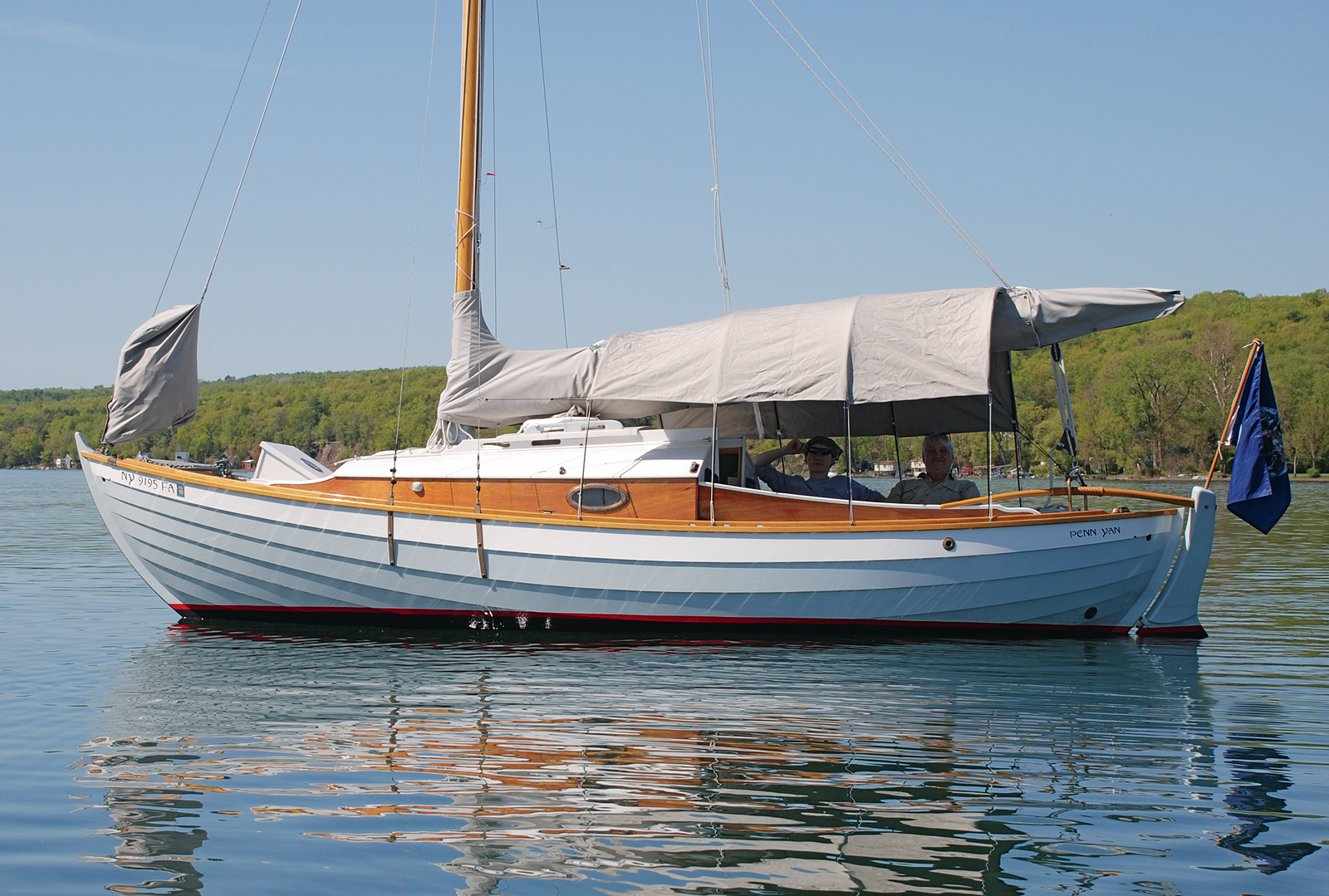 Photo by Geoff Kerr
Photo by Geoff KerrHouse sides flow forward, past the cabin. Looking aft, the coaming also flows beyond its border.These exten- sions provide good toeholds, and their varnished surfaces lead the eye to a thoughtful interplay between painted surfaces, which contribute to WATERDOG’s stunning profile. A bright toerail completes the picture.
The tow package, which approaches 6,000 lbs, pulls readily behind a standard-sized, four-wheel-drive pick-up. A V-8, yes, but certainly not a monster truck, and well within reason as an everyday vehicle in the North Country. While trailer brakes are standard with a rig of this size, other keys to the rig’s success are the load- distribution bars which spread the tongue weight more evenly among front and rear wheels of the tow vehicle. This boat, its trailer, and a mildly oversized door in one bay of the Hohms’ garage allow WATERDOG to “hibernate” between seasons.
My singular impression of Grey Seal in the flesh is of a serious small ship. This vessel is a fully realized, full-featured cruising boat with adult-sized components carried on a small hull. She somehow manages to be robust yet graceful, and compact without looking “cute.” She is stoutly rigged without seeming overburdened. Hardware and rigging are sized and laid out for seaworthiness without looking too “epic,” one of Moray MacPhail’s particular fears. Her accommodations are spartan but functional. The Hohms have two individual berths that serve for seating and sleeping, each one fitted with a lee-side catch-all; a simple galley with a critically important gimbaled stove; and a full-sized marine head, installed without space-hogging partitions. Their choices make for open, weather-tight, and homey living for two.
The cockpit is an important domestic space on a boat of this size, doing double duty as the saloon. WATER- DOG’s custom “chuck wagon” awning encourages use of this space during wet and—as important—hot and sunny weather. While up to four adults could spend a comfortable day aboard, the boat is best thought of as a cruiser for only two, who will find her comfortable for serious, shall we say, medium-term cruising.
 Photo by Geoff Kerr
Photo by Geoff KerrWATERDOG offers a “cozy” sleeping space for two and a basic galley at the companionway. The gimbaled propane single burner attached to the stan- chion between berths makes getting the morning coffee an easier reach for the bleary-eyed.
Craig chose to include a two-cylinder 10-hp diesel that turned out to be a bit of a squeeze. (Oughtred’s drawings provide only the merest indication of engine details.) Consequently, WATERDOG’s mechanicals took a full year to spec, lay out, and install. With that struggle now behind, the reliable, amply sized auxiliary not only extends the Hohms’ cruising range and their ability to meet a schedule, but provides some peace of mind should conditions get dicey.
Some final thoughts about the options included in the design and the choices made for WATERDOG: Craig and Sue have found little or no difference in the boat’s sailing ability with the board up or down, so I’d be tempted to simplify construction and build the keel version which, being only slightly deeper, really wouldn’t make much difference in trailering or in cruising.
The rig options don’t really seem an option to me. The gunter rig is so much more attractive that, in my opinion, the marconi drawing should be discarded! Besides its good looks, the gunter rig’s shorter mast has less windage at anchor and is easier to step and unstep.
The Grey Seal design probably marks the upper limit of the “Small Boats” concept. Even a patient home builder will spend a considerable amount of capital to realize this dream, and having one professionally built will up the ante, big-time. She may well be worth it, though, for this superb vessel is as lovely and as capable as anything I could ever imagine. She captures the Norse spirit—but in an eminently accessible form.
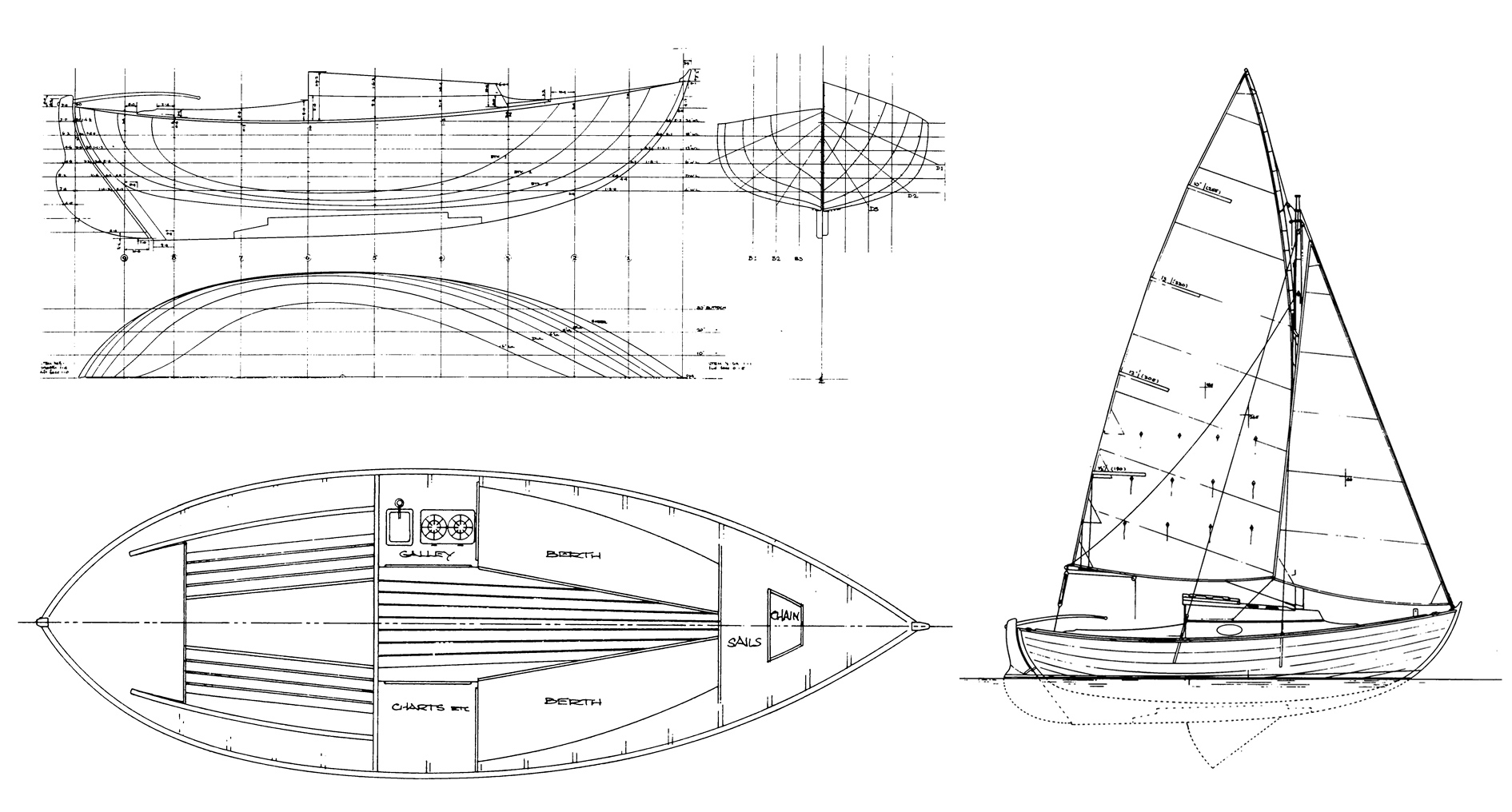
Grey Seal’s lines promise a hearty, buoyant, and able boat. That hint of hollow aft in her waterlines contrib- utes to the lightness in the look of her stern.
This Boat Profile was published in Small Boats 2010 — plans are available from The WoodenBoat Store.
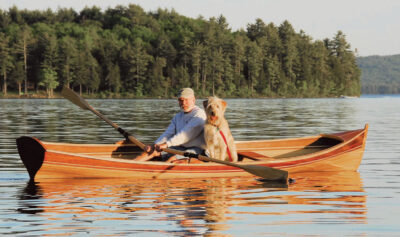
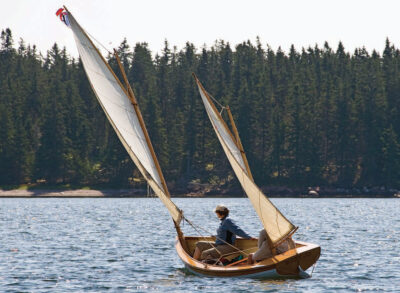
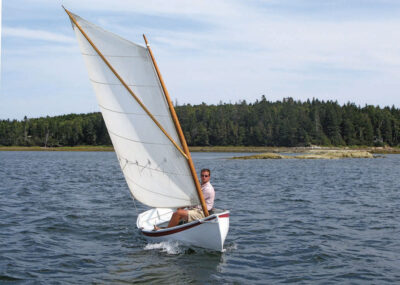
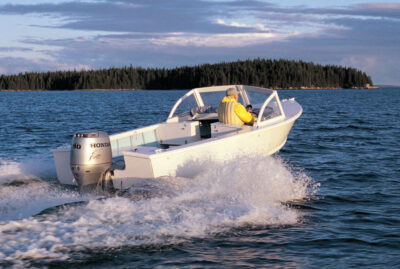
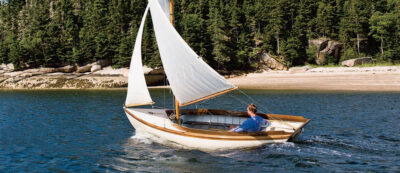
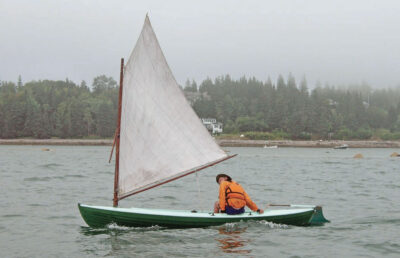


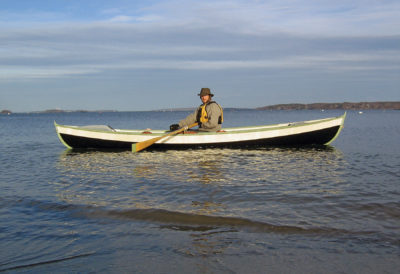
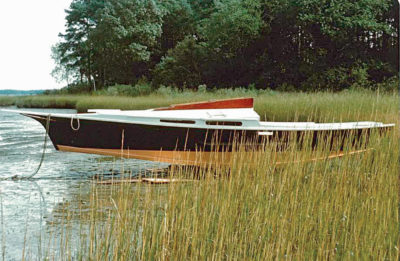
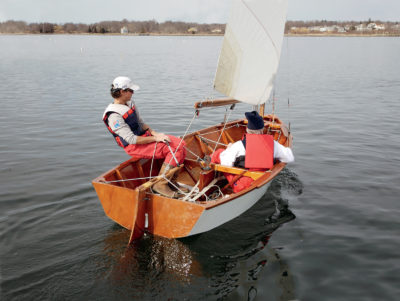
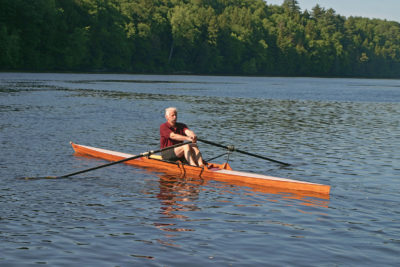
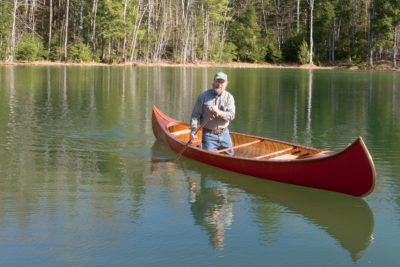
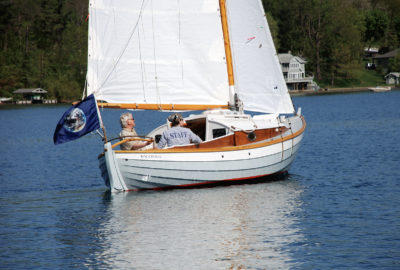
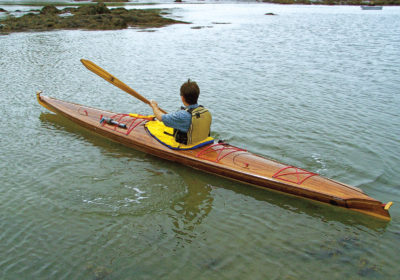
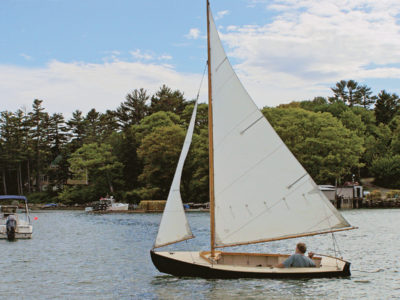
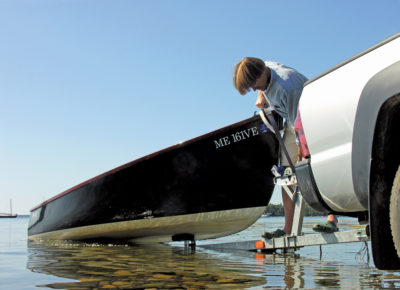
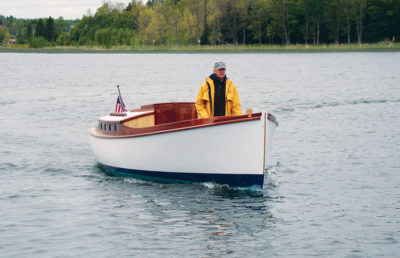
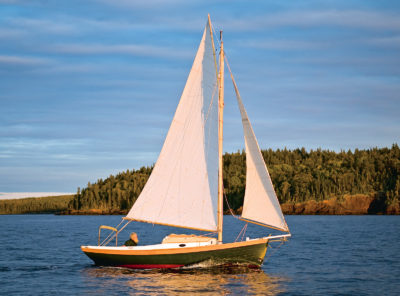
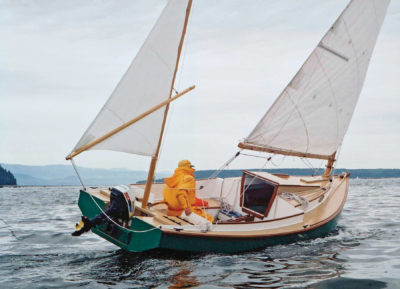
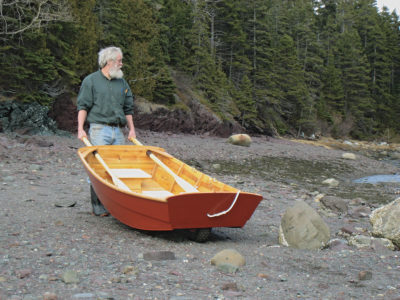
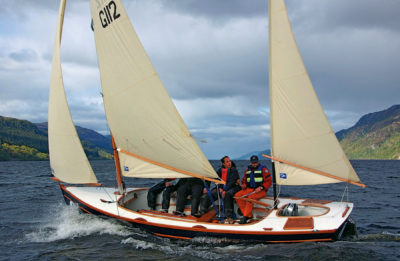
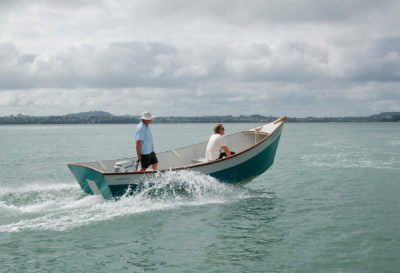

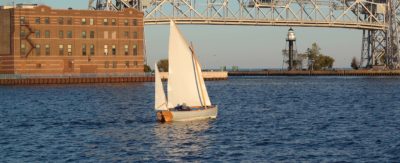
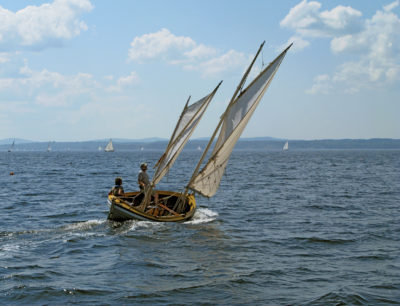
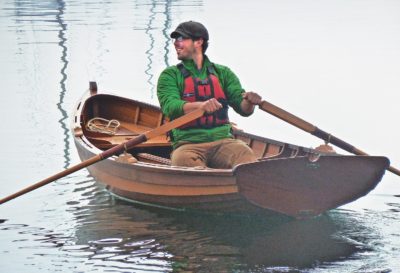
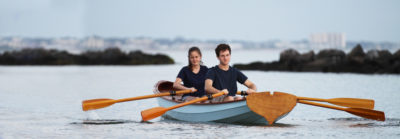
Gorgeous
A real pleasure just to see the pictures of Grey Seal. She looks like a very seaworthy, stable,
and trusting little gem. To have built her must be a rewarding experience and to be
able to sail and enjoy her the nth reward. May you have her for many years to come.